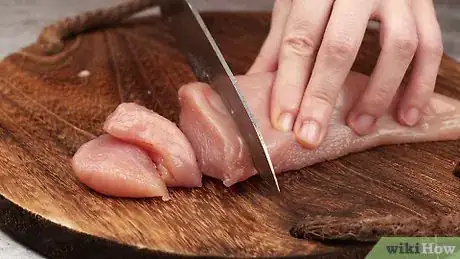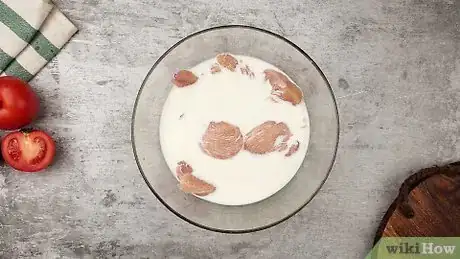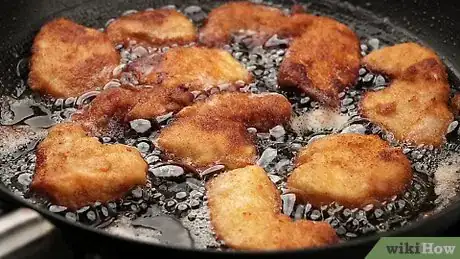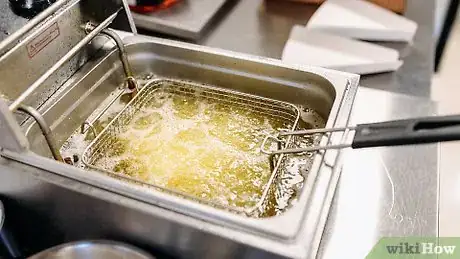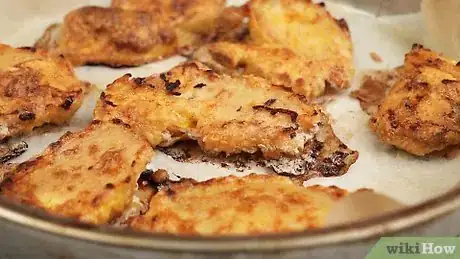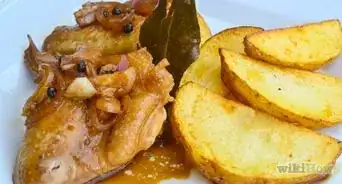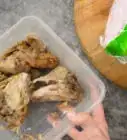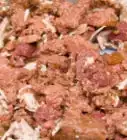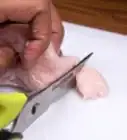This article was co-authored by wikiHow Staff. Our trained team of editors and researchers validate articles for accuracy and comprehensiveness. wikiHow's Content Management Team carefully monitors the work from our editorial staff to ensure that each article is backed by trusted research and meets our high quality standards.
The wikiHow Culinary Team also followed the article's instructions and verified that they work.
This article has been viewed 85,769 times.
Learn more...
Chicken tenders are a favorite at restaurants in the USA and around the world. Surprisingly simple to make yet always a giant mess, there are as many different chicken tender recipes as there are chefs. Luckily, the basics are pretty easy -- you coat the chicken in fat (egg or buttermilk) and flour, then fry or bake in oil. Once you have these down, you can start adjusting testing, and fine-tuning to your own taste buds.
Ingredients
- 1 lb boneless chicken (breasts or pre-cut tenders)
- 1 cup all-purpose flour
- 1 cup breadcrumbs
- 2 eggs or 1 cup buttermilk
- Cooking oil (canola, vegetable, or peanut)
- Spices, to taste
Steps
Making Breaded Chicken Tenders
-
1Rinse off a boneless chicken breast and cut it into strips. You can also buy pre-cut chicken, often sold as "Fajita Chicken" or simply "Chicken Tenders," but it is often a bit more expensive than buying a breast and cutting it yourself. Aim for evenly cut pieces, each roughly 1-1/2" thick.
- After rinsing, be sure to pat the chicken strips dry with paper towels.
-
2Take 1 cup flour, 1 cup breadcrumbs, and 2-3 beaten eggs and place each in a separate bowl. Making chicken tenders requires you to dunk the chicken in three separate baths, which together create the rich, delicious, and crispy coating on the outside of the chicken. Set them up now, with a little extra of each nearby if you run out while working.
- The eggs should be whipped with a fork, as if you were about to scramble them.
- Keep the flour and breadcrumbs nearby in case you need to refill the bowls while coating the chicken.
Advertisement -
3Add any desired seasonings to the flour. You can use whatever spices you want, but generally a teaspoon of salt, some pepper is essential. From there, toss in paprika, cumin, cayenne, thyme, or whatever other spices you desire. There are few wrong answers.
- You can season the fingers in a variety of ways, but they will be delicious even if you only use salt and pepper.
-
4Dip the chicken in the flour, turning to coat lightly. You want a nice, light dusting of flour here, not large chunks or clumps.
-
5Take the floured chicken and dip it in the egg wash, draining off any excess liquid. Again, the chicken doesn't want to be sopping wet, just evenly coated. When adding to the egg, a pair of kitchen tongs will go a long way towards keeping your hands and workstation relatively clean.
-
6Press the wet chicken into the breadcrumbs to coat. This is your crunch, and the egg and flour together should form a sort of glue to hold everything together. When done, set the thrice-coated chicken on a plate and move on to the next strip. When choosing breadcrumbs, you have a lot of options:
- Traditional Breadcrumbs are small, and lead to a lightly breaded flavor.
- Panko Breadcrumbs are large and crispy, and lead to a very crunchy final finger
- Flavored Breadcrumbs are a great way to simple and easily add some spice to your dish.[1]
-
7Cook the tenders by pan-frying, deep-frying, or baking. The way you cook the chicken depends on your taste and nutritional needs. Once you have the coating on, it doesn't matter much how you choose to cook the tenders, as they are thin pieces that cook quickly and evenly without much maintenance.
Making Buttermilk Chicken Tenders
-
1Soak your chicken tenders in a dish of buttermilk for at least 2-3 hours. Buttermilk will tenderize the chicken, and adds some much-needed fat to the lean mean, keeping the final tenders moist and delicious. You can use straight buttermilk, or create a spiced buttermilk marinade for additional flavor. To do so, simply add a half teaspoon of the following spices to your buttermilk, stir well, and use this to coat the chicken:
- Paprika
- Cayenne
- Dried green onions
- Black pepper
- Cracked red pepper
- Garlic powder
- 1 tablespoon salt[2]
-
2In a shallow dish, mix 1 cup of flour with salt, pepper, and 2 tablespoons of buttermilk. Stir with a fork until the flour clumps up lightly, almost like wet sand. The touch of salt and pepper can be augmented by an additional teaspoon of the spices mentioned above as well, though this is up to personal spice preference.[3]
- If you're out of buttermilk you can use a little regular milk, or even water, to clump up the flour. These clumps create the delicious crispy coating for your tenders.
-
3Remove the chicken strips from the buttermilk and dredge in flour. Let some of the excess liquid drain off first. Then liberally coat each piece of buttermilk chicken in your flour mixture. Each strip should have an even coating of flour, with several big clumps attached as well.[4]
- It can help to use a fork or tongs to prevent messes while working with wet chicken.
-
4Cook the chicken by either pan-frying, deep-frying, or baking, depending on your preferences. Traditionally, buttermilk chicken is deep fried, giving it the rich (though not necessarily healthy) flavor and texture than makes southern-fried chicken so popular. But you can cook this recipe on a stovetop or in the oven without losing much, and you may even find you prefer these lighter, less oily versions.
Cooking Your Chicken Tenders
-
1Pan fry your tenders for a flavorful, quick, and rich chicken tender. Simple and easy, all you need is a heavy bottom skillet, pot, or pan. Fill it with roughly 1/2 inch vegetable oil and heat over medium-high until shimmering, like a pond disturbed by a light breeze. Then, add the chicken fingers, cooking on each side for 1-2 minutes before flipping.[5] Once both sides are golden brown, place the chicken on a paper towel-lined plate to drain and cool.
- Be careful of spitting oil when cooking, especially when adding cold chicken to a hot pan.
- Don't crowd the pan, as this lowers the oil temperature rapidly and leads to soggy chicken. Each piece should have some room to move.
- If the oil starts darkening or smoking, pour it out safely and heat up more oil. Dirty oil won't do your meal any favors.[6]
-
2Deep-fry your tenders at 375F/190C for restaurant quality chicken. Fill the fryer with your favorite high-heat oil (vegetable, canola, and peanut are all common) and set it to 375F. Once it is ready, toss in the chicken strips, taking care not to overcrowd the pot. They should have room to move around freely, allowing all sides of the chicken to cook. Fry for 6-8 minutes or until golden brown, and cool them on a paper-towel lined plate or wire rack before serving.[7]
-
3Bake your chicken tenders for a healthy option that doesn't sacrifice flavor. Baking requires the least oil, keeping the chicken much lighter than frying would. Before you start coating, pre-heat the oven to 425F and line a baking sheet with aluminum foil. Bake the coated chicken for 15-20 minutes, making sure you flip the tenders at the halfway mark. When golden brown, check that the inside of one of the thickest tenders is cooked all the way through, not pink, and then cool and serve.[8]
Community Q&A
-
QuestionHow do I cook uncooked chicken tenders in the microwave?
 Community AnswerCover dish with plastic wrap, folding back one corner or edge 1/4 inch to vent steam. Microwave on Medium (50%) 14 to 16 minutes or until juice of chicken is no longer pink when center of thickest pieces are cut and temperature reaches 170°. Let stand 5 minutes.
Community AnswerCover dish with plastic wrap, folding back one corner or edge 1/4 inch to vent steam. Microwave on Medium (50%) 14 to 16 minutes or until juice of chicken is no longer pink when center of thickest pieces are cut and temperature reaches 170°. Let stand 5 minutes. -
QuestionCan I use a rotisserie?
 GrowingNanaCommunity AnswerIf you care to butcher a raw rotisserie chicken, then any piece of meat will work. However, it should not be done with a pre-cooked chicken, as the food will turn out dry and unpleasant.
GrowingNanaCommunity AnswerIf you care to butcher a raw rotisserie chicken, then any piece of meat will work. However, it should not be done with a pre-cooked chicken, as the food will turn out dry and unpleasant.
Warnings
- Frying is the process of boiling things in oil! Boiling oil is very hot!⧼thumbs_response⧽
- If the oil begins to smoke, cover immediately then remove from heat.⧼thumbs_response⧽
Things You'll Need
- One twelve inch (30cm) cast iron frying pan
- A cooking surface (stove, oven, or deep-frier)
- Three shallow dishes
- One mixing bowl
References
- ↑ http://allrecipes.com/recipe/16669/fried-chicken-tenders/
- ↑ http://thepioneerwoman.com/cooking/quickie-homemade-chicken-strips/
- ↑ http://www.onceuponachef.com/2012/01/buttermilk-fried-chicken-tenders-2.html
- ↑ http://www.onceuponachef.com/2012/01/buttermilk-fried-chicken-tenders-2.html
- ↑ http://thepioneerwoman.com/cooking/quickie-homemade-chicken-strips/
- ↑ http://thepioneerwoman.com/cooking/quickie-homemade-chicken-strips/
- ↑ http://allrecipes.com/recipe/16669/fried-chicken-tenders/
- ↑ http://www.bettycrocker.com/recipes/oven-fried-chicken-tenders/46a69e4d-4c31-485b-9d43-67d40b353f2e
About This Article
To cook chicken tenders, start by heating vegetable oil in a pan over medium-high heat. Then, add your chicken tenders to the pan and cook them for 1-2 minutes on each side or until both sides are golden brown. For a healthier option, bake the chicken tenders in the oven for 15-20 minutes at 425 degrees Fahrenheit, flipping them over halfway through. To learn how to deep fry chicken tenders, scroll down!
